Radonovich et al. JAMA 2019 Sep 3;322(9):824-33
The advantage of N95 respirators over surgical masks in controlled settings were not demonstrated in preventing staff influenza infection in routine primary care.
Steels E, et al. Inflammopharmacology 2019 Jun;27(3):475-85.
Palmitoylethanolamide (PEA) cannot be recommended as a routine therapy for knee osteoarthritis in Australian primary care,
Osani et al. Korean J Intern Med 2019 Mar 15
Duloxetine (60-120 mg daily) appears to have a small to moderate beneficial effect on knee osteoarthritis pain and function at 3 months, compared to placebo.
Beadle et al. Ann Emerg Med 2016 Jul;68(1):1-9 e1.
Nasal inhalation of isopropyl alcohol provides clinically important relief from acute nausea, of at least a short duration, in community ambulatory patients
Bisson et al. Cochrane database of systematic reviews 2013 Dec 13(12):CD003388
Eye movement desensitisation and reprocessing (EMDR) appears to be effective for post-traumatic stress disorder (PTSD) symptoms.
Previous
Next
Journal reference:Radonovich LJ, Jr., Simberkoff MS, Bessesen MT, et al. N95 Respirators vs Medical Masks for Preventing Influenza Among Health Care Personnel: A Randomized Clinical Trial. JAMA 2019 Sep 3;322(9):824-33
Link: http://dx.doi.org/10.1001/jama.2019.11645
Published: September 2019
 Evidence cookie says… |
The advantage of N95 respirators over surgical masks in controlled settings were not demonstrated in preventing staff influenza infection in routine primary care.
- other protective activities may need to be prioritised, e.g., frequent handwashing, and use of isolation for higher risk patients (e.g., children) with suspected respiratory infection
- where N95 respirators are indicated, they need to be fitted properly, and should not be used in isolation
|
 A version of this article was published in the on the AusDoc.Plus online platform in the Clinical Focus Examining the Evidence section under the title, “Do N95 respirators reduce infection risk compared to surgical masks?” on 27 February 2020. [PDF pre-print]
A version of this article was published in the on the AusDoc.Plus online platform in the Clinical Focus Examining the Evidence section under the title, “Do N95 respirators reduce infection risk compared to surgical masks?” on 27 February 2020. [PDF pre-print]
Tam M. Do N95 respirators reduce infection risk compared to surgical masks? AusDoc.Plus. 2020 Feb 27. https://www.ausdoc.com.au/examining-evidence/do-n95-respirators-reduce-infection-risk-compared-surgical-masks
Continue reading
Permanent link to this article: https://evidencebasedmedicine.com.au/?p=1791
Journal reference: Steels E, Venkatesh R, Steels E, Vitetta G, Vitetta L. A double-blind randomized placebo controlled study assessing safety, tolerability and efficacy of palmitoylethanolamide for symptoms of knee osteoarthritis. Inflammopharmacology 2019 Jun;27(3):475-85.
Link: http://dx.doi.org/10.1007/s10787-019-00582-9
Published: March 2019
 Evidence cookie says… |
Palmitoylethanolamide (PEA) cannot be recommended as a routine therapy for knee osteoarthritis.
- This pilot study of well people demonstrated small effects on pain and function (WOMAC) that are likely not clinically important.
- Dosage and formulation of PEA is unclear.
- It isn’t available in Australia without special order and compounding.
|
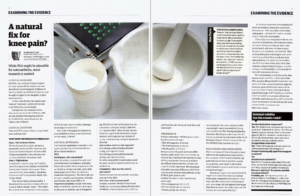 An abridged version of this article was first published in the September-October 2019, which is the final print issue, of Medical Observer, under the title “A natural fix for knee pain”.
An abridged version of this article was first published in the September-October 2019, which is the final print issue, of Medical Observer, under the title “A natural fix for knee pain”.
It also also published in the AusDoc.Plus online platform under the title, “Can this CAM compound help with knee pain?” on 25 September 2019.
Tam M. A natural fix for knee pain? Medical Observer. 2019 September-October. pp 34-5.
Continue reading
Permanent link to this article: https://evidencebasedmedicine.com.au/?p=1787
Journal reference:Osani MC, Bannuru RR. Efficacy and safety of duloxetine in osteoarthritis: a systematic review and meta-analysis. Korean J Intern Med 2019 Mar 15
Link: https://dx.doi.org/10.3904/kjim.2018.460
Published: March 2019
 Evidence cookie says… |
Duloxetine (60-120 mg daily) appears to have a small to moderate beneficial effect on knee osteoarthritis pain and function at 3 months, compared to placebo.
- side-effects need to be considered – around a third experience gastrointestinal side-effects
- it does not appear to be more effective than NSAIDs
- people with chronic pain may have a bimodal response – either very poor or very good
|
 An abridged version of this article was published in the July 2019 issue of Medical Observer.
An abridged version of this article was published in the July 2019 issue of Medical Observer.
Tam M. Duloxetine as treatment for knee osteoarthritis pain. Medical Observer. 2019 July 12.
Online version on AusDoc.Plus platform: “Is an SNRI effective in knee OA?”
Continue reading
Permanent link to this article: https://evidencebasedmedicine.com.au/?p=1782
Journal reference: Beadle KL, Helbling AR, Love SL, April MD, Hunter CJ. Isopropyl Alcohol Nasal Inhalation for Nausea in the Emergency Department: A Randomized Controlled Trial. Ann Emerg Med 2016 Jul;68(1):1-9 e1.
Link: https://dx.doi.org/10.1016/j.annemergmed.2015.09.031
Published: July 2016
 Evidence cookie says… |
Nasal inhalation of isopropyl alcohol provides clinically important relief from acute nausea, of at least a short duration, in community ambulatory patients
- method: deep inhalation of a commercial “alco-wipe” type pad held an inch in front of the nose
- this is a reasonable initial clinic intervention where immediate anti-emetics would otherwise be used
|
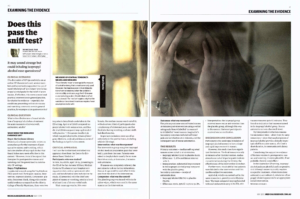 An abridged version of this article was published in the May 2019 issue of Medical Observer.
An abridged version of this article was published in the May 2019 issue of Medical Observer.
Printed edition:
Tam M. Does it pass the sniff test? Medical Observer. 2019 May 9. pp. 40-41.
Online version on AusDoc.Plus platform:
“Can inhaling ‘alco-wipes’ ease acute nausea?”
Continue reading
Permanent link to this article: https://evidencebasedmedicine.com.au/?p=1768
Journal reference: Bisson JI, Roberts NP, Andrew M, Cooper R, Lewis C. Psychological therapies for chronic post-traumatic stress disorder (PTSD) in adults. Cochrane database of systematic reviews 2013 Dec 13(12):CD003388
Link: https://dx.doi.org/10.1002/14651858.CD003388.pub4
Published: December 2013
 Evidence cookie says… |
Eye movement desensitisation and reprocessing (EMDR) appears to be effective for post-traumatic stress disorder (PTSD) symptoms.
- the quality of the evidence is low
- the uncertainty to the effect-size estimate precludes a confident comparison of effectiveness with other therapies (such as trauma-focussed CBT)
- choice of initial therapy may depend on patient preferences, and local access and availability
|
This article was published in the March 2019 issue of Medical Observer under the title “Eyeing the past to end trauma”, and online under the title “Eye movement desensitisation and reprocessing for PTSD”.
Continue reading
Permanent link to this article: https://evidencebasedmedicine.com.au/?p=1762
Journal reference: Yilmaz E, Alpsoy E, Basaran E. Cimetidine therapy for warts: a placebo-controlled, double-blind study. J Am Acad Dermatol 1996 Jun;34(6):1005-7
Link: https://doi.org/10.1016/S0190-9622(96)90279-0
Published: June 1996
 Evidence cookie says… |
The limited research evidence does not support the use of oral cimetidine as the treatment of common warts
- anecdotal evidence of major benefits are not seen in blinded randomised trials
- although cimetidine is often seen as benign, side-effects were reported in a fifth of participants in one study
|
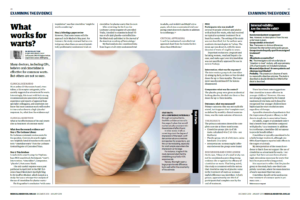 This article was published in the December 2018 / January 2019 issue of Medical Observer under the title “What works for warts?” (PDF)
This article was published in the December 2018 / January 2019 issue of Medical Observer under the title “What works for warts?” (PDF)
Continue reading
Permanent link to this article: https://evidencebasedmedicine.com.au/?p=1756
Journal reference: Gaul C, Diener HC, Danesch U, Migravent Study G. Improvement of migraine symptoms with a proprietary supplement containing riboflavin, magnesium and Q10: a randomized, placebo-controlled, double-blind, multicenter trial. J Headache Pain 2015;16:516.
Link: https://dx.doi.org/10.1186/s10194-015-0516-6
Published: April 2015
 Evidence cookie says… |
The evidence for combination magnesium, riboflavin, and CoQ10 is at best equivocal for migraine prophylaxis
- this trial had substantial threats to its internal validity and its results might be biased
- a third of participants reported adverse effects, probably from the high dose magnesium
- it should not be recommended routinely for migraine prophylaxis
|
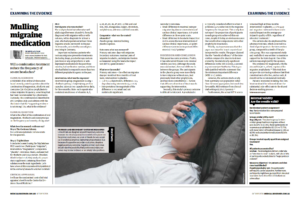 The article was published in the October 2018 issue of Medical Observer, under the title “Mulling migraine medication”.
The article was published in the October 2018 issue of Medical Observer, under the title “Mulling migraine medication”.
Continue reading
Permanent link to this article: https://evidencebasedmedicine.com.au/?p=1752
Journal reference:Friedman BW, Cisewski D, Irizarry E, et al. A Randomized, Double-Blind, Placebo-Controlled Trial of Naproxen With or Without Orphenadrine or Methocarbamol for Acute Low Back Pain. Ann Emerg Med 2018 Mar;71(3):348-56 e5
Link: https://dx.doi.org/10.1016/j.annemergmed.2017.09.031
Published: March 2018
 Evidence cookie says… |
Orphenadrine provides no benefit when used in addition to naproxen for acute low back pain
- the point estimate is close to zero, with the imprecision of the estimate well within the minimal clinically significant difference
- it should not be used routinely in the management of acute low back pain
|
 The article was published in the August 2018 issue of Medical Observer, under the title “Mulling muscle relaxants”.
The article was published in the August 2018 issue of Medical Observer, under the title “Mulling muscle relaxants”.
Continue reading
Permanent link to this article: https://evidencebasedmedicine.com.au/?p=1747
Journal reference: McGuinness B, Craig D, Bullock R, Passmore P. Statins for the prevention of dementia. Cochrane database of systematic reviews 2016 Jan 4(1):CD003160
Link: http://dx.doi.org/10.1002/14651858.CD003160.pub3
Published: January 2016
 Evidence cookie says… |
Statins should not be used as a prophylaxis against dementia, as the only indication
- the limited evidence from high quality randomised trials suggests no effect
- there is some ambiguity as observational data has tended to suggest a protective effect
|
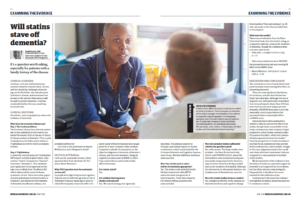 The article was published in the June 2018 issue of Medical Observer, under the title “Will statins stave off dementia?” (PDF).
The article was published in the June 2018 issue of Medical Observer, under the title “Will statins stave off dementia?” (PDF).
Continue reading
Permanent link to this article: https://evidencebasedmedicine.com.au/?p=1742
Journal reference: Chen AC, Martin AJ, Choy B, et al. A Phase 3 Randomized Trial of Nicotinamide for Skin-Cancer Chemoprevention. New England Journal of Medicine 2015 Oct 22;373(17):1618-26
Link: http://dx.doi.org/10.1056/NEJMoa1506197
Published: October 2015
 Evidence cookie says… |
Nicotinamide (vitamin B3) has a small-modest effect as prophylaxis against non-melanoma skin cancers
- the dose used in this study was 500 mg twice daily
- it reduced the number of new non-melanoma skin cancers by ~25% at a year
- the benefit may be minimal for people with few previous skin cancers (< 6 in the previous 5 years)
|
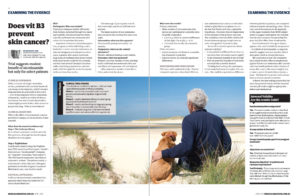 The article was published in the April 2018 issue of Medical Observer, under the title “Does vit B3 prevent skin cancer” (PDF).
The article was published in the April 2018 issue of Medical Observer, under the title “Does vit B3 prevent skin cancer” (PDF).
Continue reading
Permanent link to this article: https://evidencebasedmedicine.com.au/?p=1737
Fetching 10 of 82 items left ...

 A version of this article was published in the on the AusDoc.Plus online platform in the Clinical Focus Examining the Evidence section under the title, “Do N95 respirators reduce infection risk compared to surgical masks?” on 27 February 2020. [PDF pre-print]
A version of this article was published in the on the AusDoc.Plus online platform in the Clinical Focus Examining the Evidence section under the title, “Do N95 respirators reduce infection risk compared to surgical masks?” on 27 February 2020. [PDF pre-print]

 An abridged version of this article was published in the July 2019 issue of Medical Observer.
An abridged version of this article was published in the July 2019 issue of Medical Observer. An abridged version of this article was published in the May 2019 issue of Medical Observer.
An abridged version of this article was published in the May 2019 issue of Medical Observer.
 The article was published in the October 2018 issue of Medical Observer, under the title “Mulling migraine medication”.
The article was published in the October 2018 issue of Medical Observer, under the title “Mulling migraine medication”. The article was published in the August 2018 issue of Medical Observer, under the title “Mulling muscle relaxants”.
The article was published in the August 2018 issue of Medical Observer, under the title “Mulling muscle relaxants”.

Recent Comments